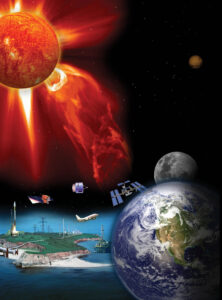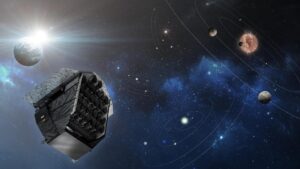Our activity is distributed across three research lines: Sun and Heliosphere, Stellar Physics, and Stellar Populations.
I. Sun and Heliosphere
The Sun and Heliosphere research line focuses on studying the solar atmosphere as well as the influence of solar activity on the heliosphere and the Earth’s atmosphere, also known as space weather.
Solar physics is a branch of astrophysics that focuses on the study of the solar atmosphere. The Sun is the most important celestial body to us. In combination with the unique properties of our planet, it provides the necessary conditions to sustain life on Earth. Although the Sun has been studied for centuries, many questions still remain unanswered, from the sudden increase in the temperature of its outermost layer, the corona, to the prediction of its activity cycles and eruptive events.

Space weather describes the time-varying conditions in the near-Earth space environment, including the solar wind, the magnetosphere, the ionosphere, and the thermosphere. The scientific aims of space weather are to understand solar activity, the interplanetary/planetary environments and the solar- and non-solar-driven perturbations that affect them, and also to forecast and nowcast the potential impact of solar activity on biological and technological systems. Having their origin in the Sun, space weather disturbances affect modern technological infrastructures, the most vulnerable of which are satellites, GNSS (Global Navigation Satellite System) navigation, communications, air navigation, electric power, and pipeline operations.
The team has vast experience in image processing, radiative transfer inversion, magnetohydrodynamic wave detection and analysis, and machine learning. We apply these techniques to a variety of data sets, e.g., to solar spectropolarimetric observations in order to study the solar atmosphere, and to in situ observations of GNSS signal disturbances, the Earth’s magnetic field etc., to better understand how solar activity influences the Earth and near-Earth heliosphere.
Currently, we participate and collaborate in several national and international projects. Members of the team lead the Portuguese participation in the European projects SWATNet and SWAIR, contribute actively to the EST Preparatory Phase, are building the first Portuguese solar spectropolarimeter, and are also developing the first detailed regional model of the ionosphere. We also maintain collaborations in the context of the SUNRISE and Solar Orbiter missions.
II. Stellar Physics
The Stellar Physics research line focuses on understanding the physical processes that take place in stars, from the stellar interior to the surface.
The team has a vast expertise in data analysis and stellar modelling, and long track record in probing the physics of stars. We develop, test, and apply seismic inference tools aimed at retrieving information on chemical mixing and segregation in order to test, improve, and validate new formulations being implemented in stellar evolution models.
The seismic analyses conducted by the team allow the measurement of the stellar mass, age, metallicity and helium abundance, the depths of the convective and helium ionization regions, as well as the properties of stellar cores. Furthermore, we also measure and study rotation and magnetic activity in stars, both through asteroseismology and low-frequency brightness variations, in order to characterize stellar magnetic cycles and their driving mechanisms. Our research in stellar physics has strong connections with the evolution of stellar systems and their interaction with the circumstellar environment, including planets.

In the context of asteroseismology, we actively participate in international consortia related to the NASA space missions Kepler/K2 and TESS. Furthermore, we are leading and participating in several PLATO (ESA) working groups. The team also contributes to the Ariel (ESA) consortium, where it is responsible for the determination of ages, masses, and radii of the stars in the mission’s Reference Sample.
The above is complemented with expertise in early stellar evolution, namely, through the detailed study of the evolution of individual pre-main-sequence (PMS) stars and their circumstellar disks. The characterization of PMS stars and their environments and, in particular, T Tauri stars (TTSs), is achieved using several strategies, namely, photometric analysis of circumstellar disks around Classical T Tauri stars (cTTSs), spectroscopic studies (UV and visible) of signatures of outflows and accretion rates, and spectropolarimetry observations using SPIRou of the complex magnetic field structures permeating TTSs. We are also involved in the modelling of the topology of the magnetospheric region surrounding these objects, in devising simulations for the connection between accretion and outflows that ultimately control their evolution, and in the determination of mass accretion rates and angular momentum losses.
Our research also includes studies of low-mass stellar and substellar populations in young clusters and star-forming regions in the Milky Way, with the goal of understanding the main formation channels of brown dwarfs and free-floating planetary-mass objects, together with their potential dependence on the star-forming environment. We are interested in the characterization of young substellar objects, their spectral properties, the prevalence of circum-substellar disks, and the potential of these objects to form their own miniature planetary systems.
III. Stellar Populations

The Stellar Populations research line focuses on the precise characterization of solar-type and red-giant stars, which provides valuable information that can be readily applied to several areas of research, including Galactic archaeology and Galactic chemical evolution.
The team has a vast expertise in using high-resolution spectroscopy to determine stellar atmospheric parameters (namely, effective temperature, surface gravity, and metallicity), as well as the surface chemical compositions of stars, which are then used to investigate the interstellar medium’s elemental enrichment history across different regions of the Milky Way (or Galaxy). The team further combines the chemical compositions of stars with accurate asteroseismic age estimates to study the formation and evolution of different stellar populations of the Galaxy and of the Milky Way as a whole.
Currently, we actively participate in several international consortia, including PLATO, Ariel, ANDES@ELT, the Maunakea Spectroscopic Explorer (MSE), ESPRESSO@VLT, NIRPS@ESO 3.6-m Telescope, SPIRou@CFHT, and the Gaia-ESO Survey (concluded), among others.
